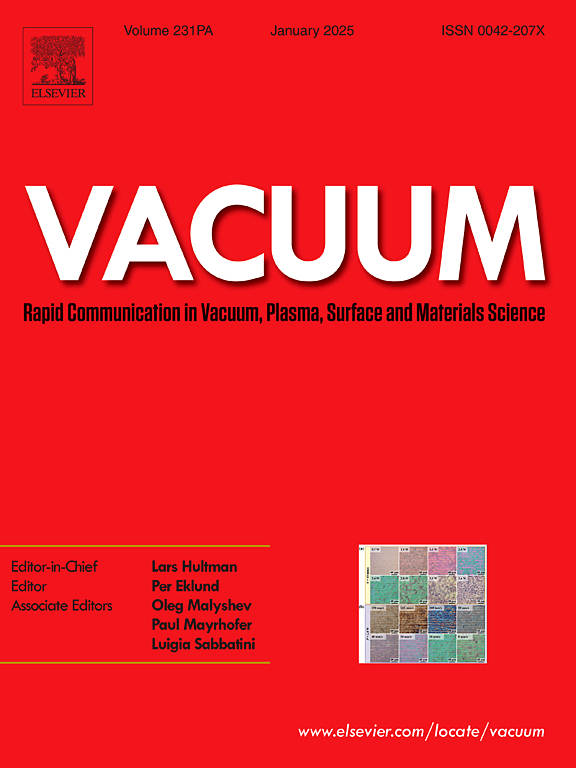Decay of secondary electron yield of MgO–Au composite film at different incident electron energies
IF 3.8
2区 材料科学
Q2 MATERIALS SCIENCE, MULTIDISCIPLINARY
引用次数: 0
Abstract
The relationship between the incident electron energy and secondary electron yield (SEY) decay of MgO–Au composite film was investigated by the designed comparison experiments. Besides the incident current and the properties of the film, the SEY value and the incident electron energy were found to be the other two key factors affecting the SEY decay rate. The value of SEY and the incident electron energy have opposite influences on the SEY decay rate, which makes it necessary to analyze the curve of incident electron energy versus SEY decay rate by dividing it into three parts. In addition, the empirical formulas for SEY decay were derived from experimental data, enabling the estimation of the SEY and decay rate of the MgO–Au composite film at any moment during SEY decay. Furthermore, the cause of SEY decay was also analyzed based on the relationship between incident electron energy and the SEY decay rate. The thermal dissipation, surface roughness, and deposition of contaminants were proven not to be the determinants of SEY decay. The experiment results in this paper supported the inference that the charging effect was the primary cause of SEY decay.
不同入射电子能量下氧化镁-金复合薄膜二次电子产率的衰减
通过设计对比实验研究了入射电子能量与氧化镁-金复合薄膜二次电子产率(SEY)衰减之间的关系。研究发现,除了入射电流和薄膜的特性之外,SEY 值和入射电子能量是影响 SEY 衰变率的另外两个关键因素。SEY值和入射电子能量对SEY衰减率的影响是相反的,因此有必要将入射电子能量与SEY衰减率的关系曲线分成三部分进行分析。此外,根据实验数据推导出了 SEY 衰变的经验公式,从而可以估算出氧化镁-金复合薄膜在 SEY 衰变过程中任何时刻的 SEY 和衰减率。此外,还根据入射电子能量与 SEY 衰减率之间的关系分析了 SEY 衰减的原因。事实证明,热耗散、表面粗糙度和污染物沉积不是 SEY 衰减的决定因素。本文的实验结果支持了充电效应是 SEY 衰减主要原因的推论。
本文章由计算机程序翻译,如有差异,请以英文原文为准。
求助全文
约1分钟内获得全文
求助全文
来源期刊

Vacuum
工程技术-材料科学:综合
CiteScore
6.80
自引率
17.50%
发文量
0
审稿时长
34 days
期刊介绍:
Vacuum is an international rapid publications journal with a focus on short communication. All papers are peer-reviewed, with the review process for short communication geared towards very fast turnaround times. The journal also published full research papers, thematic issues and selected papers from leading conferences.
A report in Vacuum should represent a major advance in an area that involves a controlled environment at pressures of one atmosphere or below.
The scope of the journal includes:
1. Vacuum; original developments in vacuum pumping and instrumentation, vacuum measurement, vacuum gas dynamics, gas-surface interactions, surface treatment for UHV applications and low outgassing, vacuum melting, sintering, and vacuum metrology. Technology and solutions for large-scale facilities (e.g., particle accelerators and fusion devices). New instrumentation ( e.g., detectors and electron microscopes).
2. Plasma science; advances in PVD, CVD, plasma-assisted CVD, ion sources, deposition processes and analysis.
3. Surface science; surface engineering, surface chemistry, surface analysis, crystal growth, ion-surface interactions and etching, nanometer-scale processing, surface modification.
4. Materials science; novel functional or structural materials. Metals, ceramics, and polymers. Experiments, simulations, and modelling for understanding structure-property relationships. Thin films and coatings. Nanostructures and ion implantation.
 求助内容:
求助内容: 应助结果提醒方式:
应助结果提醒方式:


